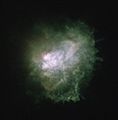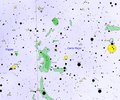VY Canis Majoris facts for kids

VY Canis Majoris (or VY CMa) is a super-duper big star! It's a type of star called a hypergiant, and it shines with a reddish light. You can find it in the sky within the constellation Canis Major, which means "Greater Dog."
This amazing star is about 3,900 light-years away from Earth. That's a really long distance! VY Canis Majoris is one of the biggest stars we know of in the entire universe. It's also one of the brightest stars of its kind.
Contents
How Big Is VY Canis Majoris?
VY Canis Majoris is incredibly huge! It is about 1,420 times wider than our own Sun. To help you imagine its size, think about this:
- If VY Canis Majoris were in the middle of our Solar System, its outer edge would reach past the orbit of Jupiter.
- Some scientists even think it might be so big that its surface would go beyond Saturn's orbit!
This star is so massive that its average density is super low. It's like having only 5 to 10 milligrams of stuff in a whole cubic meter of space. That's less dense than the air you breathe!
What Kind of Star Is It?
VY CMa is a single star, meaning it doesn't have another star orbiting it. It's also a "semiregular" variable star. This means its brightness changes over time, but in a somewhat predictable way. Its brightness cycle takes about 2,001 days to complete.
What Happens When It Dies?
Like all stars, VY Canis Majoris will eventually run out of fuel. When this happens, scientists expect it to explode in a huge event called a Supernova. This explosion would be incredibly bright and powerful. After the supernova, what's left of the star is expected to collapse and turn into a Black hole.
Related pages
Images for kids
-
Portrait of Jérôme Lalande in 1802
-
This image from the Hubble Space Telescope shows the cloud of gas and dust around VY CMa. The star is in the middle.
-
This image was taken by the ESO's Very Large Telescope. It shows the cloud around VY CMa. The star itself is hidden behind a dark circle.
-
VY Canis Majoris (the brightest star) and the cloud of gas and dust around it. (Image from Rutherfurd Observatory/Columbia University)
See also
 In Spanish: VY Canis Majoris para niños
In Spanish: VY Canis Majoris para niños







